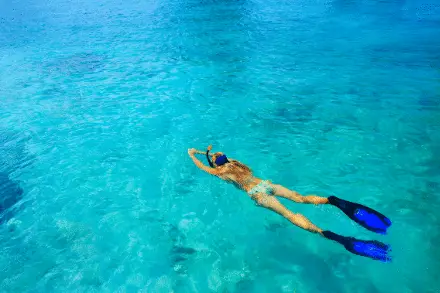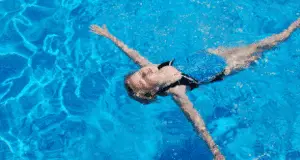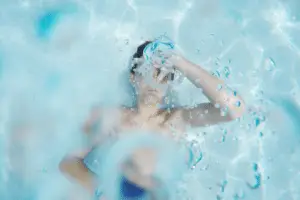Snorkeling is an exhilarating experience that quickly becomes a hobby for travelers worldwide. Not only are we able to witness the beauty of life underwater, but there are often some fantastic shipwrecks and other underwater treasures to be explored. It’s a fun way to explore the ocean, but what if you don’t know how to swim?
Snorkeling instructors don’t usually require that their clients are avid swimmers because no law stipulates it. So which is it? Is swimming a prerequisite to snorkeling, or can you get by without it? The simple answer is, you don’t need to learn how to swim if you want to enjoy snorkeling. Non-swimmers can enjoy snorkeling just as much if they take the proper safety precautions and learn a few techniques.
You Need To Be Comfortable In Water
 Some people have an intense fear of drowning, known as aquaphobia. People with aquaphobia are probably not looking for snorkeling locations. Many people, however, have a milder form of the condition whereby they are anxious when in water. Snorkeling requires breathing underwater (through the snorkel) for a prolonged time, which can be difficult for those who aren’t comfortable in the water.
Some people have an intense fear of drowning, known as aquaphobia. People with aquaphobia are probably not looking for snorkeling locations. Many people, however, have a milder form of the condition whereby they are anxious when in water. Snorkeling requires breathing underwater (through the snorkel) for a prolonged time, which can be difficult for those who aren’t comfortable in the water.
Floating
 Although swimming is not a requirement, snorkeling involves a lot of floating in the water (face-down). Essentially, it is a surface sport, so you don’t really need to dive into the water at all. Most of the wonders that you explore when snorkeling can be seen from the surface clearly.
Although swimming is not a requirement, snorkeling involves a lot of floating in the water (face-down). Essentially, it is a surface sport, so you don’t really need to dive into the water at all. Most of the wonders that you explore when snorkeling can be seen from the surface clearly.
Many people take part in snorkeling activities using a life-jacket, which is completely acceptable. You may not be able to dive and get up close to the things you are exploring, but the experience is enjoyable nonetheless. A thick neoprene wetsuit is also helpful in increasing your buoyancy if needed.
Movement In Water
Most snorkeling locations are in shallow water. However, they may not be shallow enough for you to walk on the sea bed with your head out of water. So, you may need some swimming techniques to help you move around to enjoy the experience more. Don’t worry, because it’s nothing complex like a swim stroke, but some movements to help you get by.
To move around, you may want to learn how to use your arms to move around a little, and if you ever feel like propelling yourself, you will need to kick your legs. Keep in mind that you can get by without any special movement techniques, especially if you’re in a life jacket.
Breathing Techniques
 One of the most important things to learn if you want to go snorkeling is a proper breathing technique. You may be breathing through the snorkel, but it’s harder than it looks. The first step is to relax and calm your breathing. If you are panicked, you are more likely to swallow some water accidentally, and the situation may quickly escalate. The more you relax, the smoother your snorkeling session will go.
One of the most important things to learn if you want to go snorkeling is a proper breathing technique. You may be breathing through the snorkel, but it’s harder than it looks. The first step is to relax and calm your breathing. If you are panicked, you are more likely to swallow some water accidentally, and the situation may quickly escalate. The more you relax, the smoother your snorkeling session will go.
To breathe through a snorkel properly, make sure you are taking deep and slow breaths. Inhale fully, and exhale fully. Resist the urge to hold your breath because although your face is submerged, your air supply is from above the surface! The only reason to ever hold your breath when snorkeling is if you dive into the water, submerging your snorkel with you. Of course, you are unlikely to try this if you aren’t already a swimmer.
Slow breathing is also important because some water will collect in the reservoir even with the best snorkel. Faster breathing is likely to cause you to swallow some of it, which will inevitably lead to coughing. So keep your breaths slow and controlled when snorkeling.
Learning the proper breathing technique also ensures that if a wave floods your snorkel, you have enough air in your lungs to avoid coughing. You will have enough air to empty the snorkel of the water inside it by forcefully exhaling into it.
Learn The Proper Position
As with swimming, it is important to have good posture when snorkeling, even if you aren’t going to swim at all. It may even be considered more important because you will want to keep your snorkel above the surface to keep the airflow steady.
Before you start snorkeling, take the time to dip your head in the water and figure out which position keeps your snorkel tube perpendicular to the surface. That is, it sticks out straight from the waterline. Usually, this means you’re looking straight ahead.
Avoid sinking your legs, and use your inflated lungs to help with your buoyancy. If you lie flat in the water (face-down), your entire body should be in a straight line. This position is also more comfortable for your neck, so you won’t tire yourself when snorkeling.
Use Your Lungs To Control Buoyancy
Even if you aren’t going to take the time to learn how to swim, it can be extremely helpful to learn how to control your buoyancy. Scuba divers need special devices to control how they float or sink in water, called a BCD. While you don’t need something so complex, you should know that your lungs are a natural floatation device!
Every time you inhale, your lungs inflate like a balloon, and you will find yourself floating nearer to the surface. Exhaling will lower you into the water as your lungs deflate. There is no need to hold your breath for this effect because your lungs naturally keep a reservoir of air even after a full exhale. Learn to control your breath to help control how you sink or float in the water, to get closer or further as needed.
This technique is also helpful if you ever find yourself overwhelmed by the feeling of lying face-down in the water. Simply turn on your back, and breathe deeply and slowly. Your lungs will keep you afloat, so you can take a break for a minute or so.
Safety Precautions
Even if you can go snorkeling without any swimming experience, it doesn’t mean you should ignore all the safety precautions. Respect the ocean and marine wildlife for what it is, and recognize that there are potential dangers. Especially if the water is deeper than your height, insist on a life jacket and make sure it works properly.
Never go snorkeling without a snorkeling instructor, even if you are a capable swimmer. It takes years of experience to learn how to deal with marine wildlife, and a snorkeling instructor will be your best protection in case of emergency.
Take the time to research your location if that will help you stay relaxed during the process. The best practice is to go snorkeling as part of a group and never wander far away from the rest of the group. An incoming wave can easily disorient you and take you out into the ocean.
Conclusion
Learning how to swim is the safest option when taking part in any recreational water sports such as snorkeling. However, it is entirely possible to enjoy snorkeling to the fullest without any swimming skills whatsoever.
Remember to breathe, keep your snorkel out of the water, and relax. Pretty soon, you’ll find that swimming is the last thing on your mind, and you’ll be enjoying the ocean wildlife completely.
